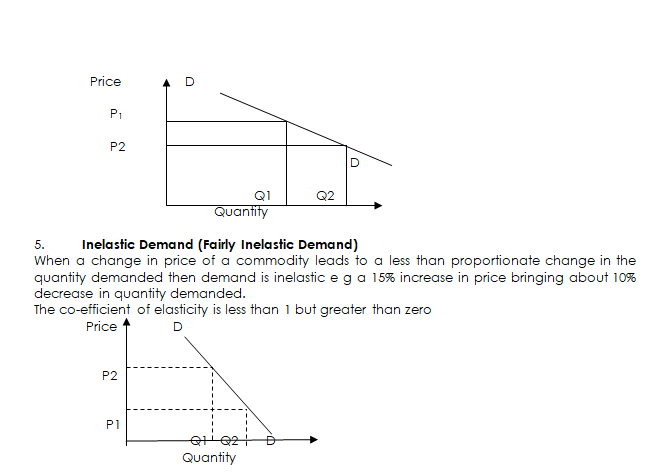Back to: ECONOMICS SS2
Welcome to class!
In today’s class, we will be talking about the elasticity of demand. Enjoy the class!
ELASTICITY OF DEMAND
/elastic-demand-definition-formula-curve-examples-3305836_V7-5b4dfb6fc9e77c001ace28a9-2697d2861dd04c90bf9d74b0435a0f0b.png)
CONTENT
- Definition of Elasticity of Demand
- Types of Elasticity of Demand
- Price Elasticity of Demand
- Types of price elasticity of demand and graphical representation
- Factors affecting elasticity of demand
DEFINITION OF ELASTICITY OF DEMAND
The elasticity of demand may be defined as the degree of responsiveness of demand as changes in price, income, prices of other commodities etc.
TYPES OF ELASTICITY OF DEMAND
- Price elasticity of demand
- Income elasticity of demand
- Cross elasticity of demand
PRICE ELASTICITY OF DEMAND
Price elasticity of demand is the degree of responsiveness of demand for a particular commodity to changes in its price. It is the rate at which the quantity demanded changes as its price changes.
To measure price elasticity of demand we use the formula:
% Change in Quantity Demanded
% change in price
This formula can be broken down or simplified as:
Old Quantity – New Quantity X 100
Old quantity
E= Old Price – New Price X 100
Old Price
Illustration
When the price of a given product is reduced from N90 to N80, the quantity demanded increases from 50 to 60 units. Deduce the co-efficient of elasticity of demand.
Solution
Old price = N90, New price = N80
Change in price = 80 – 90 = -10
= 10 x 100
90 1 = 11.1%
Old quantity = 50, New quantity = 60
Change in quantity = 60 – 50 = 10
= 10 x 100
50 1 = 20%
PE = 20
11.1 = 1.8%
TYPES OF PRICE ELASTICITY OF DEMAND
The types of elasticity of demand and their graphical representation can be shown as follows:
- Perfectly Elastic (or Infinitely Elastic) Demand.
Consumers react sharply to changes in price. They are willing to buy all the goods available at a particular price and none at all at a slightly higher price. The co-efficient of elasticity tends to infinity.


FACTORS AFFECTING (OR DETERMINING) ELASTICITY OF DEMAND
- Availability of Close Substitutes: A commodity that has close substitutes is likely to have an elastic demand
- Degree of Necessity of the Goods: If a commodity is a necessity or a near-necessity, increase or decrease of its price are not likely to affect its demand
- The proportion of Consumer’s Income that Is Spent on that Commodity: Generally the higher a persons income, the more inelastic his demand for commodities
- Habit: If a consumer has become addicted to a commodity, his demand for the goodwill tend to be monastic. An increase in the price of the commodity may therefore not affect (reduce) his quantity demanded.
- The Level of Consumer’s Income: The larger the income of the consumer the more inelastic is his demand for commodities. On the other hand, the demand of consumers with low income tends to be elastic.
- Cheap Commodities: The cost of some commodities are relatively insignificant and as such consumers demand them will be inelastic.
GENERAL EVALUATION
- What is abnormal demand?
- High the importance of opportunity cost to the government.
- Explain three differences between a public corporation and a public limited liability company.
- Distinguish between peasant farming and commercial farming.
- Why is scarcity a fundamental problem in Economics?
In our next class, we will be talking about Elasticity of Supply. We hope you enjoyed the class.
Should you have any further question, feel free to ask in the comment section below and trust us to respond as soon as possible.

I don’t understand this solution, the break down of the formular is given as old qty – new qty*100/old qty, but while solving it u did new qty-old qty*100/old qty. please help me out
this was an interesting study